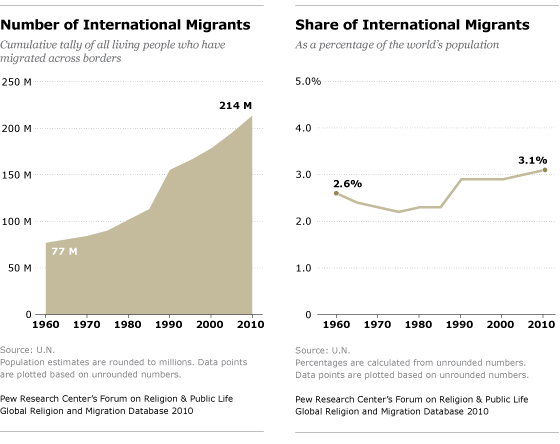 People are on the move, and so are their faiths.
People are on the move, and so are their faiths.
The total number of international migrants living around the world has grown substantially over the past 50 years, climbing from about 80 million people (or 2.6% of the world’s population) in 1960 to about 214 million (or roughly 3% of the world’s population) in 2010, according to estimates by the United Nations Population Division.

At times in history, religious persecution and strife have been major causes of migration. But many experts think that, on the whole, economic opportunities – better jobs and higher wages – have been the single biggest driver of international migration. At the same time, religion remains a factor in some people’s decisions to leave their countries of birth and their choices of where to go. And, regardless of motive, the movement of millions of people across oceans and continents can have significant effects on the religious makeup of nations.
In the United States, for instance, more than a century of immigration by Catholics, Jews, Muslims, Buddhists, Hindus, Sikhs and others has contributed to the gradual reduction of the once-overwhelming proportion of Protestants, which has fallen from two-thirds of the U.S. public in the 1960s to about half today. In Western Europe, a more recent influx of Muslim immigrants is producing political tensions along with greater cultural diversity. And in some of the oil-rich Gulf states, large numbers of foreign workers – including Hindus from India, Christians from the Philippines and religiously unaffiliated people from Europe and North America – are changing the face of once-homogeneous societies.
To better understand the relationship of migration and religion, the Pew Research Center’s Forum on Religion & Public Life began more than a year ago to build a database of information that combines hundreds of censuses, surveys and other sources to shed light on the origins, destinations and religious affiliations of international migrants. This report draws on the new Global Religion and Migration Database to estimate the religious breakdown of all international migrants living around the world as of 2010. The database is akin to a puzzle assembled from hundreds of thousands of tiny pieces. It allows us to see – for the first time – a global picture of where migrants have come from, where they have gone and their religious composition.
The picture is, inevitably, fuzzy in places. Some pieces of the puzzle are missing (reliable survey or census data on the religious affiliation of immigrants are not available for every country), and some pieces do not fit perfectly together (censuses and surveys in different countries gather information in ways that are sometimes difficult to harmonize). So it is important to emphasize that the figures in this report are estimates, not precise counts.
Still, this emerging picture of the religious affiliation of international migrants is much clearer than what demographers and social scientists previously have been able to produce. General readers also may be surprised by some of the findings. We can now see, for example, that Europe has more Christian immigrants than Muslim immigrants; that Saudi Arabia is the top destination country for Muslim migrants; and that the United States is the No. 1 destination not only for Christian migrants but also for Buddhists and for people who have no particular religion.
This report is just a beginning – a baseline look at the nominal affiliation of migrants, with no attempt to measure their levels of religious commitment. We hope to gather additional data over time, so that we can more closely examine the experience of immigrants in particular countries. For example, future reports may explore whether migration tends to increase or decrease the religiosity of migrants, the role of religion in how immigrants adapt to their new surroundings, and other related issues. With its surveys in the United States and around the world, the Pew Forum also will continue to explore the connections between people’s religious beliefs and practices and their social and political attitudes.
Faith on the Move is part of the Pew-Templeton Global Religious Futures project, which analyzes religious change and its impact on societies around the world. Previous reports produced under this initiative, funded by The Pew Charitable Trusts and the John Templeton Foundation, include Global Christianity: A Report on the Size and Distribution of the World’s Christian Population (December 2011), Rising Restrictions on Religion (August 2011), Global Survey of Evangelical Protestant Leaders (June 2011), The Future of the Global Muslim Population: Projections for 2010-2030 (January 2011), Tolerance and Tension: Islam and Christianity in Sub-Saharan Africa (April 2010), Global Restrictions on Religion (December 2009), Mapping the Global Muslim Population: A Report on the Size and Distribution of the World’s Muslim Population (October 2009) and Spirit and Power: A 10-Country Survey of Pentecostals (October 2006).
The principal researcher for Faith on the Move and architect of the Global Religion and Migration Database is Pew Forum Research Associate Phillip Connor, Ph.D. Jeffrey Passel of the Pew Research Center’s Hispanic Center contributed important insights at several stages of the project. We also received invaluable assistance and feedback on drafts of this report from Guy Abel of the Vienna Institute of Demography, Christopher Parsons of the University of Nottingham, Philippe Fargues of the European University Institute and Michael Fix of the Migration Policy Institute. With all this generous help, any failings of this report are, needless to say, ours alone.
Luis Lugo, Director
Alan Cooperman, Associate Director, Research


